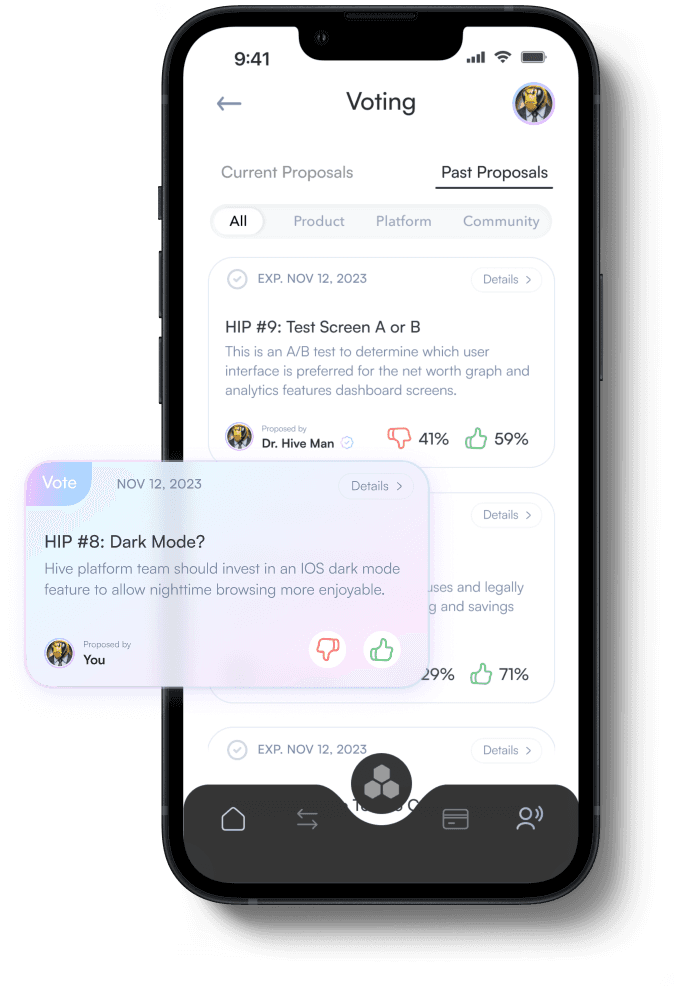Designing for Hive
Designing for Hive
Designing for Hive
Designing for Hive
Designing for Hive
Designing for Hive
Sep 20, 2023
Sep 20, 2023
Sep 20, 2023



Design Notes #1
This is Bean, the designer for Hive.
It's not every day you come across hearing a revolutionary idea, and even rarer to see something being done about it. As someone who has been fascinated by the web3 movement for the past couple of years, the prospect of creating a financial service app owned and operated by a DAO (Decentralized Autonomous Organization) was truly intriguing. Not only would we be capitalizing on a banking crisis, but we would also get to build on-chain smart contract solutions to democratize historically centralized services.
But beyond ‘what’ Hive wanted to build, the "why" and "how" behind it struck me the most.
Before Web3
Allow me to take a step back (you can skip ahead to "Finding Web3" if you don't care) because I believe it's important to reflect on how experiences and inclinations influence our decisions.
My design career unofficially began while pursuing an engineering degree at university. As a lifelong sneaker collector, I was particularly interested in working with athletes to design sustainable performance shoes. Early on in the industry, I realized that the manufacturing process, from prototyping to production, made me feel disconnected from the users I was researching, designing, and testing for. This reminded me that design is important to me because it enables me to connect and respond to people's needs.
Finding Web3
Like many others, I was introduced to web3 through Topshot in late 2020. Being a sports junkie, collecting digital collectibles for NBA highlights, I discovered a new layer being built on the internet—one in which users had ownership of verifiable assets. Through the journey of exploring projects like Bored Ape Yacht Club (BAYC), I began to understand the value and evolution of IP ownership and distribution. The Degen summer of 21’ was quite a thrill but experiencing trustless, permission less systems first hand, led me to take a professional role where I helped bridge the gap between web2 and web3 experiences.
Not only did it feel like the creator economy had finally arrived, but I also believed that my specific set of passions and hobbies prepared me to create better experiences for users who are interested in custody of their assets, utilizing smart contracts for trustless transactions, DAOs, amongst many on chain/decentralized solutions. Using the user-centered and iterative process, once again, I began designing digital experiences, prototyping my own apps, and freelancing for NFT projects until I met Dr. Hiveman. Despite the shift in focus, it felt like a natural progression.

Meeting Dr. Hiveman and DAO FatherFranks
Let's reiterate the goals of Hive:
Listening first to provide users with a voice in the platform, product, and community.
Developing a suite of financial services from the ground up and continuously iterating.
Designing DAO interaction experiences and optimizing the decision-making process for the collective immediately captivated me as a web3 head. But as a designer in the space, this is what I find special:
Users will vote on product features and incentives not through referral codes or promotions, but through ownership, providing genuinely incentivized feedback. If you haven't noticed yet, most of what I do—even "work"—is personal, and I cannot express how genuinely excited I am to build using on-chain mechanics to iterate, and perfect a suite of products to complement the HIVE financial journey.
I can confidently say that we have a team of brilliant minds all dedicated to improving the "Hive way." At Hive, we are deeply encouraged by all of this innovation and hopeful about the opportunity to help fix broken incentivization models across various industries in the coming decades. While the entire world undoubtedly wants a bank for the people, we understand that the current technical and logistical challenges have made this seemingly unattainable. Our job is to change that, not only by delivering a better user experience but also by demonstrating to the world that DAOs and and protocols can be efficient, fair, and progressive ways of making decisions.
This is likely the first of many blog posts, because building in public is just what we do in web3. Much of what we build will be experimental and learning experiences and more importantly, we need to hear your voices, and we want you to hear ours. We will be working closely with the community on three key aspects: platform, community, and product.
Therefore, a significant part of our design process will be publicly recorded, albeit in retrospect (to avoid front-running). We will be sharing design decisions for the Hive brand and app in future blog posts. For those of you who vote, you will have a direct impact on how Hive looks and feels.
We look forward to seeing some of you in our community Figma/FigJam boards (coming soon), conducting A/B tests for screens in our app, and breaking it all down in this blog.
That's how we believe it's all going to work.

Design Notes #1
This is Bean, the designer for Hive.
It's not every day you come across hearing a revolutionary idea, and even rarer to see something being done about it. As someone who has been fascinated by the web3 movement for the past couple of years, the prospect of creating a financial service app owned and operated by a DAO (Decentralized Autonomous Organization) was truly intriguing. Not only would we be capitalizing on a banking crisis, but we would also get to build on-chain smart contract solutions to democratize historically centralized services.
But beyond ‘what’ Hive wanted to build, the "why" and "how" behind it struck me the most.
Before Web3
Allow me to take a step back (you can skip ahead to "Finding Web3" if you don't care) because I believe it's important to reflect on how experiences and inclinations influence our decisions.
My design career unofficially began while pursuing an engineering degree at university. As a lifelong sneaker collector, I was particularly interested in working with athletes to design sustainable performance shoes. Early on in the industry, I realized that the manufacturing process, from prototyping to production, made me feel disconnected from the users I was researching, designing, and testing for. This reminded me that design is important to me because it enables me to connect and respond to people's needs.
Finding Web3
Like many others, I was introduced to web3 through Topshot in late 2020. Being a sports junkie, collecting digital collectibles for NBA highlights, I discovered a new layer being built on the internet—one in which users had ownership of verifiable assets. Through the journey of exploring projects like Bored Ape Yacht Club (BAYC), I began to understand the value and evolution of IP ownership and distribution. The Degen summer of 21’ was quite a thrill but experiencing trustless, permission less systems first hand, led me to take a professional role where I helped bridge the gap between web2 and web3 experiences.
Not only did it feel like the creator economy had finally arrived, but I also believed that my specific set of passions and hobbies prepared me to create better experiences for users who are interested in custody of their assets, utilizing smart contracts for trustless transactions, DAOs, amongst many on chain/decentralized solutions. Using the user-centered and iterative process, once again, I began designing digital experiences, prototyping my own apps, and freelancing for NFT projects until I met Dr. Hiveman. Despite the shift in focus, it felt like a natural progression.

Meeting Dr. Hiveman and DAO FatherFranks
Let's reiterate the goals of Hive:
Listening first to provide users with a voice in the platform, product, and community.
Developing a suite of financial services from the ground up and continuously iterating.
Designing DAO interaction experiences and optimizing the decision-making process for the collective immediately captivated me as a web3 head. But as a designer in the space, this is what I find special:
Users will vote on product features and incentives not through referral codes or promotions, but through ownership, providing genuinely incentivized feedback. If you haven't noticed yet, most of what I do—even "work"—is personal, and I cannot express how genuinely excited I am to build using on-chain mechanics to iterate, and perfect a suite of products to complement the HIVE financial journey.
I can confidently say that we have a team of brilliant minds all dedicated to improving the "Hive way." At Hive, we are deeply encouraged by all of this innovation and hopeful about the opportunity to help fix broken incentivization models across various industries in the coming decades. While the entire world undoubtedly wants a bank for the people, we understand that the current technical and logistical challenges have made this seemingly unattainable. Our job is to change that, not only by delivering a better user experience but also by demonstrating to the world that DAOs and and protocols can be efficient, fair, and progressive ways of making decisions.
This is likely the first of many blog posts, because building in public is just what we do in web3. Much of what we build will be experimental and learning experiences and more importantly, we need to hear your voices, and we want you to hear ours. We will be working closely with the community on three key aspects: platform, community, and product.
Therefore, a significant part of our design process will be publicly recorded, albeit in retrospect (to avoid front-running). We will be sharing design decisions for the Hive brand and app in future blog posts. For those of you who vote, you will have a direct impact on how Hive looks and feels.
We look forward to seeing some of you in our community Figma/FigJam boards (coming soon), conducting A/B tests for screens in our app, and breaking it all down in this blog.
That's how we believe it's all going to work.

Design Notes #1
This is Bean, the designer for Hive.
It's not every day you come across hearing a revolutionary idea, and even rarer to see something being done about it. As someone who has been fascinated by the web3 movement for the past couple of years, the prospect of creating a financial service app owned and operated by a DAO (Decentralized Autonomous Organization) was truly intriguing. Not only would we be capitalizing on a banking crisis, but we would also get to build on-chain smart contract solutions to democratize historically centralized services.
But beyond ‘what’ Hive wanted to build, the "why" and "how" behind it struck me the most.
Before Web3
Allow me to take a step back (you can skip ahead to "Finding Web3" if you don't care) because I believe it's important to reflect on how experiences and inclinations influence our decisions.
My design career unofficially began while pursuing an engineering degree at university. As a lifelong sneaker collector, I was particularly interested in working with athletes to design sustainable performance shoes. Early on in the industry, I realized that the manufacturing process, from prototyping to production, made me feel disconnected from the users I was researching, designing, and testing for. This reminded me that design is important to me because it enables me to connect and respond to people's needs.
Finding Web3
Like many others, I was introduced to web3 through Topshot in late 2020. Being a sports junkie, collecting digital collectibles for NBA highlights, I discovered a new layer being built on the internet—one in which users had ownership of verifiable assets. Through the journey of exploring projects like Bored Ape Yacht Club (BAYC), I began to understand the value and evolution of IP ownership and distribution. The Degen summer of 21’ was quite a thrill but experiencing trustless, permission less systems first hand, led me to take a professional role where I helped bridge the gap between web2 and web3 experiences.
Not only did it feel like the creator economy had finally arrived, but I also believed that my specific set of passions and hobbies prepared me to create better experiences for users who are interested in custody of their assets, utilizing smart contracts for trustless transactions, DAOs, amongst many on chain/decentralized solutions. Using the user-centered and iterative process, once again, I began designing digital experiences, prototyping my own apps, and freelancing for NFT projects until I met Dr. Hiveman. Despite the shift in focus, it felt like a natural progression.

Meeting Dr. Hiveman and DAO FatherFranks
Let's reiterate the goals of Hive:
Listening first to provide users with a voice in the platform, product, and community.
Developing a suite of financial services from the ground up and continuously iterating.
Designing DAO interaction experiences and optimizing the decision-making process for the collective immediately captivated me as a web3 head. But as a designer in the space, this is what I find special:
Users will vote on product features and incentives not through referral codes or promotions, but through ownership, providing genuinely incentivized feedback. If you haven't noticed yet, most of what I do—even "work"—is personal, and I cannot express how genuinely excited I am to build using on-chain mechanics to iterate, and perfect a suite of products to complement the HIVE financial journey.
I can confidently say that we have a team of brilliant minds all dedicated to improving the "Hive way." At Hive, we are deeply encouraged by all of this innovation and hopeful about the opportunity to help fix broken incentivization models across various industries in the coming decades. While the entire world undoubtedly wants a bank for the people, we understand that the current technical and logistical challenges have made this seemingly unattainable. Our job is to change that, not only by delivering a better user experience but also by demonstrating to the world that DAOs and and protocols can be efficient, fair, and progressive ways of making decisions.
This is likely the first of many blog posts, because building in public is just what we do in web3. Much of what we build will be experimental and learning experiences and more importantly, we need to hear your voices, and we want you to hear ours. We will be working closely with the community on three key aspects: platform, community, and product.
Therefore, a significant part of our design process will be publicly recorded, albeit in retrospect (to avoid front-running). We will be sharing design decisions for the Hive brand and app in future blog posts. For those of you who vote, you will have a direct impact on how Hive looks and feels.
We look forward to seeing some of you in our community Figma/FigJam boards (coming soon), conducting A/B tests for screens in our app, and breaking it all down in this blog.
That's how we believe it's all going to work.

